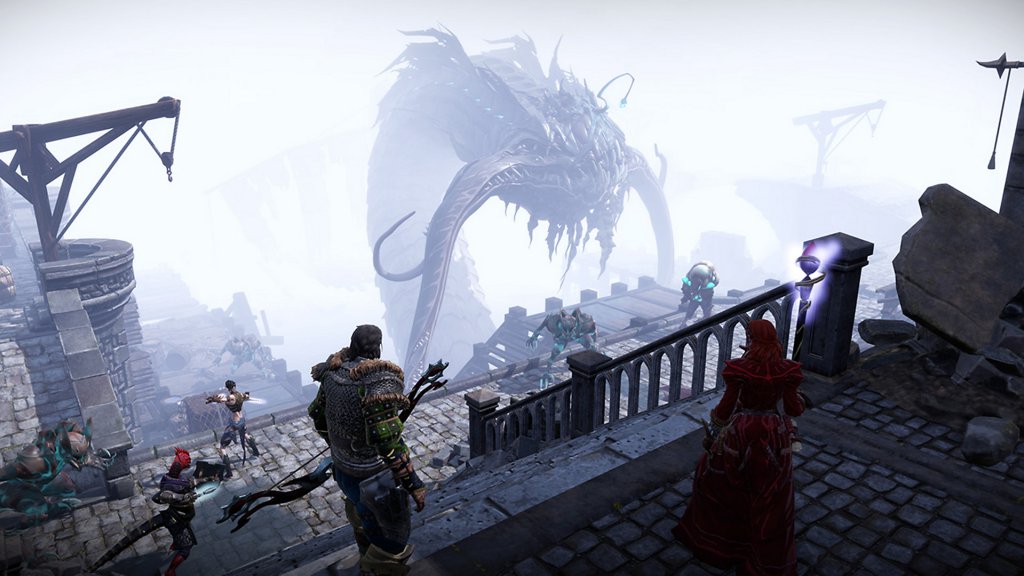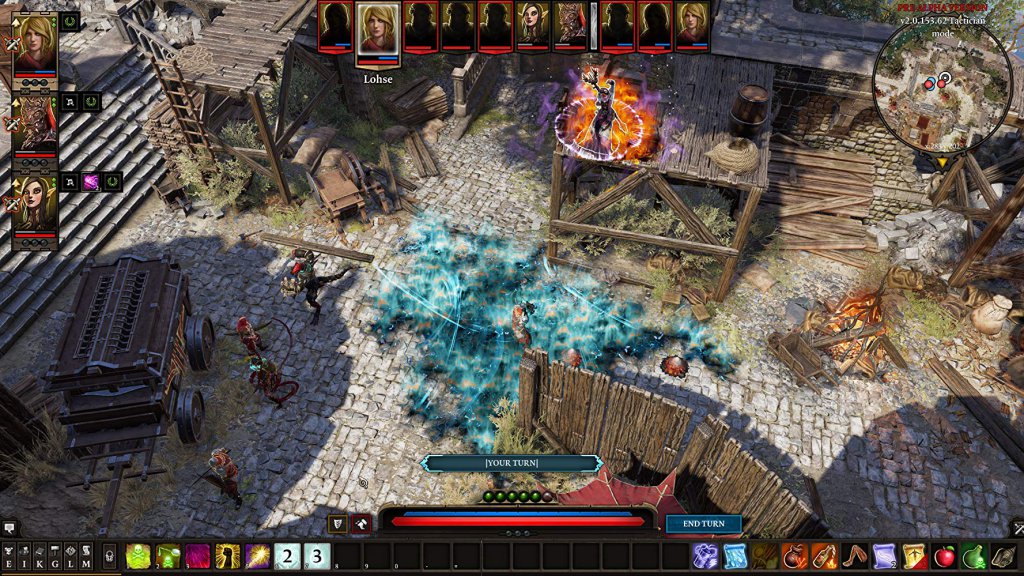Even though the original Divinity: Original Sin was well renowned for being one of the toughest old school RPG’s available, I somehow bested it thanks to years of experience from similar games. It’s sequel, Divinity: Original Sin II took me over six months and several playthroughs to complete, so what on Earth was I doing wrong?
I went into Larian Studios latest epic brimming with confidence, such is my skill at mastering tactical RPG’s. Baldur’s Gate, Planescape Torment, both Pillars of Eternity games and even Wasteland 2 have all succumbed to my challenge, even on the hardest difficulty settings. Divinity: Original Sin II, on the other hand, is a completely different beast.
This is a game that is so hard, for a while I didn’t think I’d even be able to see enough of it to write a credible review. Thankfully, as the result of several restarts, a number of class tweaks and even the occasional walkthrough video, I’ve now seen the game through to completion, albeit with a number of the settings tweaked to make the experience less punishing.
At first, I thought that I might need to craft an elaborate commentary on exactly why a developer like Larian might choose to invest significant time and effort into an RPG that so few people would be able to experience. But then again, since I first played Divinity: Original Sin II in Microsoft’s Preview programme, several difficulty options have been phased in, including those that make the game focused almost solely on exploration and story, rather than challenging combat.
Personally, I still enjoy the thrill of a tough as nails role playing game that demands long term strategic thinking from its players, as well as the ability to rapidly assess the changing situation in live combat. Divinity: Original Sin II, even if it is occasionally frustratingly challenging, lays these demands out like no other game I’ve played. The player character and each member of their motley crew must be setup to specialise hard, right from the outset.
 The characters that the players can choose from are a subtle remix of the standard range of fantasy tropes, and whilst there is a freeform character creation system, I prefer to use one of the named characters. Each of these (from the dwarven pirate to the elvish assassin who is hell bent on vengeance) bring their own personality, voice acting and standard class build, but Divinity: Original Sin II doesn’t restrict the player. Instead, the game gives players absolute freedom to setup the team however they choose.
The characters that the players can choose from are a subtle remix of the standard range of fantasy tropes, and whilst there is a freeform character creation system, I prefer to use one of the named characters. Each of these (from the dwarven pirate to the elvish assassin who is hell bent on vengeance) bring their own personality, voice acting and standard class build, but Divinity: Original Sin II doesn’t restrict the player. Instead, the game gives players absolute freedom to setup the team however they choose.
Whilst this would never sensibly result in a team made up entirely of mages, rogues or rangers, it’s entirely within the players gift to create such a dream team. Character development cannot be undone during normal play, so investing points into civil and martial skills, as well as base attributes must be carefully chosen. Additionally, skill books teach often rare abilities to characters who meet their prerequisites.
This freedom to build classes as you see fit, along with the wide and varied range of abilities that exist in the world can result in some outlandish builds. You can make a battlemage who attacks from range using fire spells to soften the enemy, before growing phantasmal bull horns and charging in to finish the fight with a battleaxe. Traditional characters, like a ranger who uses infused arrows and summons animals, are also entirely possible — the combinations are almost limitless.
This is helpful, really, because the enemies in Divinity: Original Sin II do not mess around. Combat is turn based and begins when two opposing parties become aware of each others presence (through dialogue or being in plain sight of one another.) When the fight begins, initiative determines the order of movement and use of abilities, with each action taken being the result of action point (AP) expenditure.
The combat is brutal and often long in Divinity II, with fights at higher difficulties almost always being taxing, regardless of how well your party is constructed. At its hardest, Divinity: Original Sin II can challenge the player right from the opening scenes, where the player battles against the disgusting voidwoken parasites, albeit with only basic weapons and armour to assist them.
By the later fights, the opposing side will often consist of upwards of ten enemies spread across a large, varied arena that has multiple points of interest. Being higher or lower than an enemy can affect damage, whilst one of Divinity’s showpieces returns in the form of the surfaces that can be used to confer various status effects (oil burns, water can be electrified, etc.)
 Getting through these later bouts is almost never a matter for luck, and each movement, attack and ability must be carefully planned and timed. Multiple save games are recommended and you’ll often need to repeat a fight three or four times until you get it just right. Permadeath can be enabled, but even in the standard difficulty modes, a dead character will stay dead unless a scroll or very powerful late game ability is used to revive them.
Getting through these later bouts is almost never a matter for luck, and each movement, attack and ability must be carefully planned and timed. Multiple save games are recommended and you’ll often need to repeat a fight three or four times until you get it just right. Permadeath can be enabled, but even in the standard difficulty modes, a dead character will stay dead unless a scroll or very powerful late game ability is used to revive them.
This is of particular note, since you probably won’t want your team mates to die thanks to their interesting story arcs. Unlike some RPG’s, Divinity: Original Sin II actually allows players to sort of experience all of the story content relating to the characters in their party first hand. There are some missions that feel like classic “ally side quest” missions, but most of these in Divinity II are simply woven into the fabric of each conversation.
More so than in most RPG’s, I wanted to explore each and every area with every member of the extended team, rather than just those in my immediate crew. Every character has a clear, intriguing and often unbelievable reason for being where they are, and you’ll want to explore all of them either in one playthrough or across several.
The overall story in Divinity: Original Sin II is one as far fetched as you have come to expect from a high fantasy adventure. In this instance, with the living deities that once blessed the land now seemingly absent, one or more so called “Godwoken” are sought by various factions throughout the world. Good and evil are not always as clear as they seem, and whilst the storyline in Divinity: Original Sin II treads familiar ground, it twists and turns nicely around the central characters in unexpected ways.
The game, from combat to the more sedate exploration sections, is beautifully represented. The darkest dungeons are filled with tiny details, whist overland there are crumbling forts, magnificent cities and otherworldly vistas to take in. A well done original score accompanies the action, as do well voiced characters that are individual and memorable.
When I began playing Divinity: Original Sin II during its first weeks on the preview program, my heart sank. The game felt punishingly hard and unbalanced, even for an experienced player, and I couldn’t see the quality of the game that lay behind the first four or five hours of torturous gameplay. Fast forward months of development and an increase in my own skills and understanding, and everything has changed.
 Divinity: Original Sin II is not only an exceptionally good game, it’s also one that stands proud among the very finest in its class. It’s a long, deep and demanding adventure that has plenty of story twists and literal dark alleys to explore, but the real backbone is the character development and combat. Fighting in Divinity II is bettered by no other tactical RPG, and nor is the players freedom to take the fight to their enemies in such diverse ways. Divinity: Original Sin II is a must have for any RPG fan; that is beyond doubt.
Divinity: Original Sin II is not only an exceptionally good game, it’s also one that stands proud among the very finest in its class. It’s a long, deep and demanding adventure that has plenty of story twists and literal dark alleys to explore, but the real backbone is the character development and combat. Fighting in Divinity II is bettered by no other tactical RPG, and nor is the players freedom to take the fight to their enemies in such diverse ways. Divinity: Original Sin II is a must have for any RPG fan; that is beyond doubt.
Divinity: Original Sin II is available now for PC, Mac, Nintendo Switch, PS4 and Xbox One.

